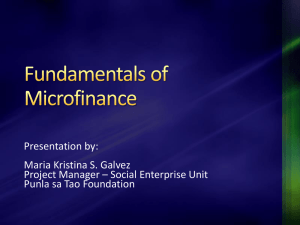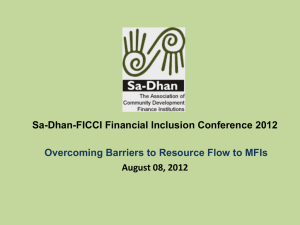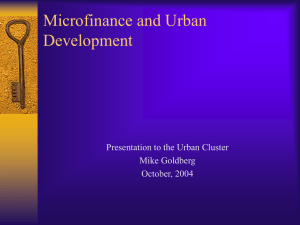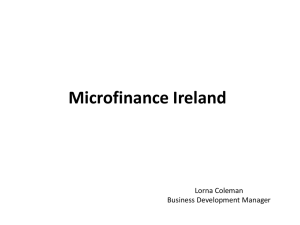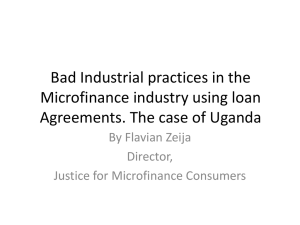Microfinance_Market_Orientation_-_2011
advertisement
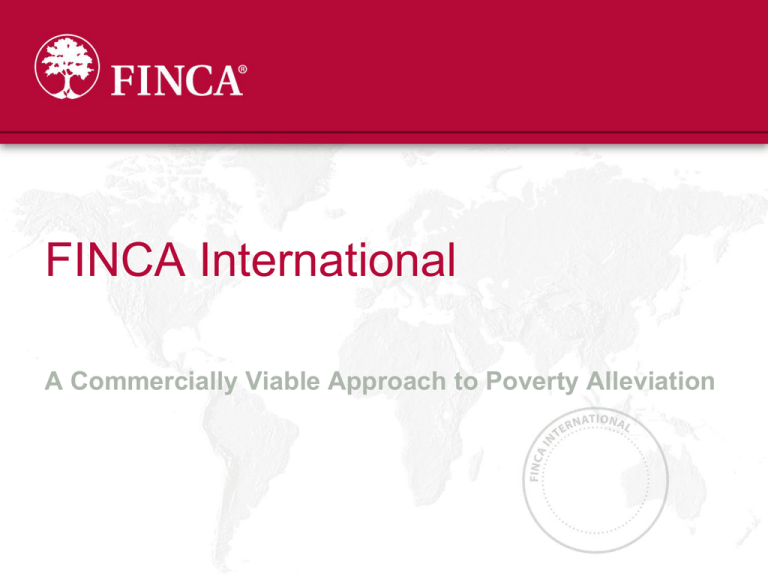
FINCA International A Commercially Viable Approach to Poverty Alleviation Market for Microfinance Gap in Financial Services Traditional financial services 100 mn people >$20,000/yr* Lacks access 1.7 billion people $1,500-$20,000/yr* 4 billion people <$1,500/yr *Numbers are in purchasing power parity in USD Source of Image -- C. K. Prahalad and Stuart Hart, 2002. The Fortune at the Bottom of the Pyramid, Strategy+ Business, Issue 26, 2002 Source of Figures -- Allen L. Hammond and William J. Kramer, 2007. The Next 4 Billion. Explaining the Gap: Perceived Risks Perceived limitations •Transaction costs are high Perceived Risks •Property rights are not well-established •Clients are geographically dispersed •Corruption and bribery by local officials •Perceived impact of client illiteracy + •Absence of information •Limited competition •Absent or imperfect regulatory framework Gap in the Availability of Financial Services Why Microfinance? Market perspective: • Capitalize on significant, untapped sector of financial market • Create jobs Social perspective: • Provide access to services • Improve socio-economic levels of clients and community • Enable intangible results such as empowerment Microfinance illustrates: • Low-income clients are profitable • Risks associated with the poor are perceived • Financial systems can meet the needs of the poor Role of Microfinance Microfinance illustrates: • low-income clients are profitable • risks are perceived • financial systems can meet the needs of the poor FINCA International Module 2: Microfinance Industry Overview Industry Overview Origins of Microfinance The development “industry” is fairly recent but development tools such as microfinance have always existed Microfinance Timeline* •Since the beginning of time: Informal savings & credit groups have always existed Development Timeline •1500s: 1st pawn shop created by Catholic Church as alternative to money lenders •Late 1940s: The concept of “Development” appears after WWII •1700s: Irish Loan Fund System began •1950s: Modernization (Big Push and/or strategic investments) •Early 1900s: Adaptations in Latin America •1960s/1970s: Dependency Theory, ISI policies, grassroots development, basic needs •1980s: Structural Adjustment •1990s: Community Development, interest in Sustainable Development swells, debt relief (HIPC/Jubilee 2000) •2000: Millennium Development Goals •1800s: Financial Cooperative developed •1950-1970: State-Owned Development Finance Institutions emerged •Early 1970s: Experimental Microcredit programs •1980s: Microcredit spreads and improves •Early 1990s: Microcredit Microfinance •Today: Blurring of lines between MFIs and traditional financial institutions *Helms, Access for All, ch. 1 Industry Overview ACCION International First microloan in Brazil, 1973 Grameen Bank Founded in Bangladesh, 1976 FINCA International First microloan in Bolivia, 1984 ProCredit Holding Founded 1998 Industry Overview Top Credit-Led Methodologies CREDIT METHODOLOY GROUP Community Lending Groups of Groups Models Village Banking ROSCAs ASCAs CO-OPs SHGs INDIVIDUAL Solidarity Group Industry Overview Overview of MFIs • Range of providers – 7,000 - 10,000 MFIs globally; exact total unknown – 1,900+ MFIs self-reporting to MIX Market* • Size of industry – $60 billion in loans – $37 billion in deposits* • Largest 29 reporting MFIs have 50% of all loans • Largest 16 reporting MFIs have 50% of all borrowers • Largest 8 have 50% of all depositors • Large variety in legal structure, mission and methodology •MixMarket, www.mixmarket.org Industry Overview Overview of MFIs • Client Base and Circulation Large and Growing – Exceeding 190 million clients, 128 million are poor** – Loans to poorest impact over 600 million people – 80% of poorest clients are women • Large variety in loan sizes* – – – – 19 have average loans > $10,000 44 have average loans $5,000 – 10,000 331 have average loans $1,000 – 5,000 521 have loans <$500 * MixMarket, www.mixmarket.org **Microcredit Summit Campaign, State of the Microcredit Summit Campaign Report 2011 Industry Overview Industry Examples Client/ Borrower MFI • Member of • Grameen • solidarity Bank, FINCA group (3-15 Affiliates • borrowers) • Local • Community financial borrower intermediary • (group of 15(post office, 40) grocery • store) • Individual loan recipient Network Rating Agency Sanabel (Middle East) AFMIN (Africa Microfinance Network) FINCA International Accion • PlaNet • Finance • Planet Rating • • MicroRate • • MicroFinanza • • M-CRIL • • Standard and • Poor’s Technical Assistance CGAP (World Bank) USAID SEEP UNDP Imp-Act Also provided by Networks and MFIs Investor/ Funder • • • • • • EBRD MicroVest ShoreCap BlueOrchard KFW City Group Foundation • Kiva • Oikocredit • Calvert Foundation Industry Overview Share of Market By Sector 5% 3% 7% 8% (65) (71) (7.7) 2% (3.3) (2.4) (2.5) 14% (123) 39% (346) 3% 32% (284) Banks Coops/Credit Unions Non-Bank Financial Institutions Non-Profits/NGOs Rural 87% (117.4) Median Outstanding Portfolio By Sector Sources: (Millions USD)** *MicroBanking Bulletin, Issue 17, Autumn 200, 35. Number of Institutions by Sector* **MicroBanking Bulletin, Issue 15, Autumn 2007, 36 (based on median gross loan portfolio) Industry Overview Minimalist v. Integrated Approach Minimalist Approach Financial Intermediation •Working Capital •Fixed Asset Loans •Savings •Insurance Social Intermediation •Group Formation •Leadership Training •Cooperative Learning Enterprise Development •Marketing •Business & Production Training •Subsector Analysis Social Services •Education •Health and Nutrition •Literacy Training Integrated Approach Microfinance Industry Overview Microfinance Models* Organization Relationship Governance & Control Market Segment Main Products Average Loan Size (USD) Services Provided to Partners / Affiliates -Affiliation by accreditation -Autonomous implementing organizations -ACCION has limited fiduciary responsibility ACCION sits on boards of some affiliates but has no control over them Medium/ High -Solidarity Groups -Individual Loans -Housing Microfinance -Microinsurance -Remittances -Savings Asia: $151 Africa: $1181 LAC: $951 US: $5700 -Provides technical assistance and financing to affiliates - Assists in transforming to commercial entities -Replicator model -No affiliates Limited board representation, control restricted to grant agreements Low -Group Lending -Housing Microfinance Estimated $350 Provides financial and technical assistance and publications to replicate the Grameen technology *Information was compiled from available published data and our best understanding of these organizations based on industry exchanges on such topics. FINCA International, Inc. Microfinance Industry Overview Microfinance Models* Organization Women’s World Banking Relationship Governance & Control Market Segment Main Products Average Loan Size (USD) Services Provided to Partners / Affiliates -Autonomous implementing partners -Control restricted to grant agreements Low -Solidarity -Group Lending -Entering Savings Models (i.e.: ROSCA/ ASCA) $275 -Multi-disciplinary organization -Programs receive access to funding & technical assistance via accreditation. - CRS develops materials, systems and training to assist programs -Autonomous implementing partners and affiliates -Accreditation system -No fiduciary responsibility - No board representation. -Some representation of local affiliates in the WWB Board. - Control restricted to grant agreements Medium -Credit -Savings -Health Insurance $467 Provides information sharing, capitalization, partial loan guarantees, and policy work *Information was compiled from available published data and our best understanding of these organizations based on industry exchanges on such topics. Microfinance Industry Overview Microfinance Models* Organization Relationship Governance & Control Market Segment Main Products Average Loan Size (USD) Services Provided to Partners / Affiliates -Autonomous implementing partners -Control restricted to grant agreements Low -Solidarity -Savings $75 -Multi-disciplinary organization -Designs and manages community-based projects in education, health care and economic development. -Complete fiduciary responsibility - Implementing organizations are independent NGOs, subsidiaries or branches of FINCA depending on local law - Majority representation on all of FINCA affiliate boards and has financial and legal control over each affiliate. Low -Village banking -Solidarity -Individual $497 Provides management oversight, monitoring, and technical assistance from start up, to self-sufficiency to transformation into commercial entities *Information was compiled from available published data and our best understanding of these organizations based on industry exchanges on such topics. Microfinance Industry Overview Microfinance Models* Organization ProCredit Relationship Governanc e & Control Market Segment -Parent company of 19 banks in Latin America, Africa and Eastern Europe -Funds businesses that have been running for at least 3 months High Main Products -Individual -Provides domestic/intern ational payments, card services, home improvement loans and ebanking services Average Loan Size (USD) 93.5% are $13,340 or less; 50% are $1,400 or less Services Provided to Partners / Affiliates -Invests in quality of client through advanced training personnel -Provides strategic guidance and management for affiliates *Information was compiled from available published data and our best understanding of these organizations based on industry exchanges on such topics. FINCA International Module 3: Microfinance Clients Microfinance Clients Segmentation by Income Microfinance can serve a range of income levels Target populations have sizable combined assets Top of Pyramid 100 mn people >$20,000/yr* 1.4 billion people $3,000 - $20,000/yr* 4 - 5 billion people <$3,000/yr * Bottom of the pyramid: • Vulnerable non-poor • Moderate poor • Extreme poor *Numbers are in purchasing power parity in USD Source of Image -- C. K. Prahalad and Stuart Hart, 2002. The Fortune at the Bottom of the Pyramid, Strategy+ Business, Issue 26, 2002 http://www.whartonsp.com/articles/article.asp?p=389714 Source of Figures -- Allen L. Hammond and William J. Kramer, 2007. The Next 4 Billion http://pdf.wri.org/n4b_executive_summary_graphics.pdf Microfinance Clients Segmentation by Income Most clients come from moderately poor and vulnerable non-poor households Moderate Poor – less than $2/day; Extreme poor – less than $1/day Source: Cohen, “The Impact of Microfinance” Microfinance Clients Typical Microfinance Clients • No access to formal financial institutions • Self-employed – Household-based, informal market, ect. • Nearly 80% women* • Urban clients – Shopkeepers, service providers, artisans, street vendors, etc. • Rural clients – Small farmers or entrepreneurs engaged in income-generating activities such as food processing or petty trade • Poor or Vulnerable Non-Poor *Among top 10 MFIs (listed In terms of total borrowers) Source: www.microfinancegateway.com/section/faq Source: Microfinance: An Emerging Market Opportunity Microfinance Clients Understanding Client Needs (a) Life-cycle needs • • • Birth, Marriage (loans, savings) Old Age (pensions) Death (insurance, savings, loans) (b) Emergencies • Illness, disasters, etc. (loans, insurance, etc.) (c) Investment opportunities • Working capital and access to funds (microenterprise loans, remittances and transfers) Source: Helms, Brigit. CGAP, Access for All Microfinance Clients Access = Opportunity to Meet Needs Access to financial services Increase & diversify incomes Build assets Mitigate risk Plan for the future Make choices Increase food consumption Invest in education & health Invest in housing, water, sanitation From Everyday Survival to Planning for the Future Microfinance Clients Regional Trends Growth in # of Borrowers 12 (in millions) 10 8 2004 2005 6 2006 2007 4 2 0 Africa Eastern Europe & Central Asia Latin America & Caribbean Middle East & North Africa Source: MicroBanking Bulletin, Issue 17, Autumn 2008, Figure 1, p. 46. http://www.mixmbb.org/Templates/CurrentIssue.aspx, accessed April 2009. FINCA International, Inc. FINCA International, Inc. Microfinance Clients Regional Trends Percent of Women Borrowers 90 (%) 80 70 60 2004 50 2005 40 2006 30 20 2007 10 0 Africa Eastern Europe & Central Asia Latin America & Caribbean Middle East & North Africa Source: MicroBanking Bulletin, Issue 17, Autumn 2008, Figure 1, p. 46. http://www.mixmbb.org/Templates/CurrentIssue.aspx, accessed April 2009. FINCA International, Inc. FINCA International, Inc. Microfinance Clients Regional Trends Average Loan Balance per Borrower 2250 2000 1750 (US$) 1500 2004 1250 2005 1000 2006 750 2007 500 250 0 Africa Eastern Latin Middle East Europe & America & & North Central Asia Caribbean Africa Source: MicroBanking Bulletin, Issue 17, Autumn 2008, Figure 1, p. 46. http://www.mixmbb.org/Templates/CurrentIssue.aspx, accessed April 2009. FINCA International, Inc. FINCA International, Inc. Microfinance Clients Regional Trends Growth in # of Depositors 5 (in millions) 4 3 2004 2005 2 2006 1 0 Africa Eastern Europe & Central Asia Latin America & Caribbean Middle East & North Africa Source: MicroBanking Bulletin, Issue 16, Spring 2008, Figure 1, p. 17. http://www.themix.org/publication_detail.aspx?publicationID=237, accessed June 2008. Microfinance Clients Industry Trends Target Market 20000 # of Active Borrowers 18000 16000 14000 2004 12000 2005 10000 2006 8000 2007 6000 4000 2000 0 Low End Broad High End Small Business Source: MicroBanking Bulletin, Issue 17, Autumn 2008, Figure 1, p. 47. http://www.mixmbb.org/Templates/CurrentIssue.aspx, accessed April 2009. Microfinance Clients Industry Trends Lending Methodology # of Active Borrowers 50000 40000 2004 30000 2005 2006 20000 2007 10000 0 Individual Individual / Solidarity Solidarity Village Banking Source: MicroBanking Bulletin, Issue 17, Autumn 2008, Figure 1, p. 47. http://www.mixmbb.org/Templates/CurrentIssue.aspx, accessed April 2009. Microfinance Clients Among the Historically Unbanked, Who Do MFIs Serve? CHARACTERISTICS Historically Underserved/Unbanked… Poverty Level “Destitute” to “Non-Poor”. Assets Varies by poverty level. Poor are largely landless with simple assets such as cell phones, radios, bicycles. Few have productive assets (tools). Gender Disproportionately female. Income Generation High participation in informal sector & agricultural sector. Location High numbers urban but poorest are largely rural. Access Limited or no access health, education, financial services, infrastructure. Other Categories Displaced persons, retrenched workers. Source: Private Sector Microfinance, Alan Doran (Oxfam), 2008 http://www.oxfam.org.uk/resources/downloads/FP2P/FP2P_Priv_Sector_Microfinance_BP_ENGLISH.pdf MFI Clients… Microfinance Clients Summary: Key Trends – Overall, increase in growth rate of # of borrowers (23%) – Highly concentrated growth – 25% of MFIs surveyed by MIX adding at least 42% of additional borrowers – – – – 7% growth in number of depositors Steady growth in percentage of women borrowers to about 64.4% Increase in average loan balance to $563 in 2006 Average of 23,431 borrowers/MFI – Greatest scale in Vietnam (556,038 borrowers/MFI) – Lowest in Barbados (384 borrowers for the 1 MFI in Barbados) – In regions where FINCA operates (all except East Asia/Pacific), average of 16,738 borrowers/MFI – Low market penetration, at an average of 7% of borrowers/poor – Industry-wide, highest # of active borrowers at low end of market – Solidarity lending methodology attracting highest # of borrowers Sources: MicroBanking Bulletin, Issue 16, Spring 2008, http://www.themix.org/publication_detail.aspx?publicationID=237, accessed June 2008; and Gonzalez, Adrian, 2007. “How Many Borrowers and Microfinance Institutions (MFIs) Exist?” Microfinance Information Exchange (MIX), Washington, D.C. http://www.themix.org/publication_detail.aspx?publicationID=215, accessed June 2008. FINCA International Module 4: Overview of FINCA International FINCA International Mission Statement MISSION The mission of FINCA International is to provide financial services to the world's lowestincome entrepreneurs so they can create jobs, build assets, and improve their standard of living. FINCA International Vision Statement VISION To become the leading global microfinance institution by providing financial services to more than one million clients annually by 2010, while operating with the highest commercial principles of performance, transparency and sustainability. FINCA is successfully achieving its vision without sacrificing the fundamental mission of serving the poorest of the productive poor FINCA International, Inc. FINCA International Social Performance Definition FINCA defines social performance as: 1. expanded access to financial services, primarily among underserved, low-income people and communities; 2. increased employment and incomes; 3. improved living standards; 4. empowerment and the achievement of personal aspirations among our clients and in their families; 5. acting responsibly and equitably towards all stakeholders, and the communities of which we are a part. Map of the Network FINCA Africa Global Headquarters Washington, DC, USA Regional Hubs Offices LAC Africa GME Eurasia Miami, FL, USA Kampala, Uganda Amman, Jordan Istanbul, Turkey Latin America Ecuador El Salvador Guatemala Haiti Honduras Mexico Nicaragua Africa DR Congo Malawi Tanzania Uganda Zambia GME Afghanistan Jordan Eurasia Armenia Azerbaijan Georgia Kosovo Kyrgyzstan Russia Tajikistan FINCA Operations Business Model Target Market: entrepreneurs on the lowest rung of the economic ladder Ownership: FINCA wholly owns and manages its worldwide network Management by local teams with intimate knowledge of local market Reporting: Encourages greater transparency & achievement of higher business standards Compliance: Meets rigorous commercial market guidelines, and social/financial expectations of international donor community This permits FINCA to leverage capital for rapid expansion Funding: Integrates donations and investments to maximize loan capital FINCA Operations Business Model – Structure HQ consolidates key functions associated with governance, strategy, audit and controls. Hubs provide regional centers of management & technical expertise Affiliates have flexibility at program & client level Policy & Strategy, HR, Accounting, Fundraising, IT, Reporting, Audit, Capital Markets, Legal Headquarters Regional Hubs Africa Eurasia LAC Affiliate Operations GME Regional Training, Program Planning & Monitoring, Product Development, Audit & Control Core operations, implementation of all functions listed above FINCA International Products and Services • • • • • • Credit Village Banking loans, small group loans, individual loans Savings Autonomous accounts, cash collateral, deposits Insurance Life/loan insurance In R&D: Health and other microinsurance Services and training Ad hoc training through partnerships including business skills training and health education Innovative Delivery Mechanisms Smart cards, VISA partnership (electronic payment technologies in pilot phases within Latin America), Shariah-compliant microfinance services in GME FINCA International Products – How a Village Bank Works Group Group Loan Repayment Interest Savings Loan Capital Village Bank Individual Loan Client •Food •Health Care •Education Sales Income Customers Self-Employment Activities FINCA International FINCA Portfolios: By Loan Type and Region Clients (,000s) Portfolio (,000s) $135,318 $629,452 169,187,026 217,428,809 VB Clients Individual Clients VB Clients Source: FINCA Global Statistics, Nov 2009 Individual Clients FINCA International Product Examples Product Terms Guatemala Village Banking Loan Tajikistan Individual Loan Georgia Solidarity Credit Group Borrower VB's from 10+ Members 3-15 members, usually adult women and mothers Urban and rural clients Interest Rate 4% Flat/month 24-36% Declining/year 36% Declining/year Fees None 1% upfront fee rate 2% (3% w/o collateral) Loan Size Ave: Q1,600 (USD 210) Typically: GEL300-400 (USD170-225) Ave: TJS 2,231 (USD 550) Loan Term 4 months and 6 months 3 months to 12 months Initial loan – 2 to 12 months 2nd cycle – up to 14 months 3rd cycle – up to 18 months Repayment Two weeks or Monthly Four weeks, 30 days Four Weeks Penalties for Delinquency As defined in Group Rules .5% (Applies to principal payment due) • Day 1-3: 10% of late principal • Day 4-10: 5% of late principal • Day 11+: 1% of late principal Eligibility Adult (18+) with existing business • Citizen with valid passport or ID • Member-decided • Adult (18+) • Good credit history • Existing business for 3 months Personal property • No collateral • One guarantor necessary • Mutual guarantee within SCG Loans up to $1000 only w/ guarantor Movable business/household assets Immovable business/household assets Gold collateral Collateral / Guarantees FINCA International Loan Amounts • • • • The average loan amount to our clients is US$641 In most markets, FINCA loan sizes are below their peer groups. 82% of loans are through village banks. Women comprise 67% of our clients. Region Africa Latin America Eurasia Middle East Total Average Disbursed $344 Average Outstanding $241 588 1,111 514 641 382 776 385 511 Source FINCA Global Statistics, December 2010 FINCA International Network Statistics Africa Latin America Eurasia Middle East CLIENT OUTREACH STATISTICS Active Village Banking Groups Active Village Banking Clients Active Individual Loan Clients 11,116 170,529 23,672 23,951 225,714 17,567 56,014 245,258 78,314 5,720 16,382 2,531 Total Active Clients % Village Banking Clients % Women 194,201 88% 58% 243,281 93% 87% 323,572 76% 47% 18,913 87% 92% PORTFOLIO STATISTICS Village Banking Loans Outstanding Individual Loans Outstanding Total Loans Outstanding 22,649,705 76,519,873 122,647,131 5,248,146 24,191,645 16,440,845 128,674,346 2,034,944 46,841,350 92,960,718 251,321,477 7,283,090 Source: FINCA Global Statistics, Feb 2010 FINCA International Network Profitability Region Indicator Africa YTD Net Operating Margin OSS Profit Margin Portfolio Yield ROA Latin America $ 1.29 mm $-3.32 mm % Variance vs. FY08 Total Eurasia GME $8.36mm $-3.49 mm $ 2,83 mm 107% 105% 97% 112% 42% 103% 0% 5% -7% 10% -131% 2% 1% 84% 62% 41% 42% 50% 4% 3% -2% 4% -15% 1% 1% Source: FINCA Global Statistics, Dec 2009 Microfinance Clients Why Women? Socio-economic reasons: * Greatest Segment of Poor (~70%) * Restricted access to education and productive resources * Greater spending for benefit of household Macroeconomic role in overall economic growth * Gender inequalities hinder growth in developing countries * Tend to spend more of the increased income on poverty-reduction, especially for their children, than poor men. – “Better poverty-reducers” and “drivers of development” Lower-risk borrowers * Better repayment rates reported from Malaysia to Malawi * Highly motivated savers * Higher likelihood to reinvest in income-generation rather than spend only on consumption http://www.fwa.org/community/microfinance.htm 13.Nov.2006 ------- http://www.villagebanking.org/faq.htm#women -------- http://www.microcreditsummit.org/papers/empowering_final.doc Sustainable banking with the poor, Johanna Ledgerwood – World Bank – p. 41 Managing Director, CASHPOR Technical services, Malaysia, http://www.fao.org/docrep/004/AC154E/AC154E03.htm Elissa McCarter, Director of the Office of Development at CHF International www.seepnetwork.org/files/5759_file_WOMEN_AND_MICROFINANCE_McCarter.doc Profile of FINCA Loan Clients Target Client Typical Client Prerequisite Has a business Has a business Demographics •Resides in an urban, peri-urban or rural setting.* •No gender preference •No age preference (in general clients are between 18 and 60 years old) •Lives in an urban area •Married Female •41 years old •Household size of 5 members or less (typically between 2-5) •Children are grown and not of school age •2 income earners per household Access Restricted access to financial services, education, and other resources Education 35% have less than 8 years 31% 8-11 years 34% 12 years or more Poverty Level In the bottom 1/2 of the population living below the local currency national poverty line.* When such info is not available, two approaches: –Low income countries: target those with <$1/day daily per capita expenditure (adjusted for purchase price parity) – Middle income countries: target those whose DPCE falls below 25% of the per capita Gross National Income. Typically between $1 - $4/day in daily per capita expenditures Other Shares FINCA’s mission goals. Knows and shares in our mission FINCA and Microfinance Profile of Typical FINCA Businesses: • Typically one business operating for one year or more • Commercial enterprises such as: – – – – – – – selling food tailoring small-holder agriculture trading hair salons pharmacies transportation – crafts • They support their families, and often others in the community (relatives, neighbors, orphans) Source: FINCA International Strategic Plan, 2006 FINCA and Microfinance Maria Lucía Ramirez – FINCA Ecuador Client “I’m so grateful because FINCA trusted me. Now I can improve my life and the life of my family.” Señora Ramirez was able to take out a $200 loan and buy wool to make and sell sweaters on the local market. F/Jordan client builds a better future Tamam used a US$300 loan to buy beehives and honey collection equipment. She runs a successful beekeeping business with 60 beehives and is a vital contributor to her family’s well-being Tamam received the 2009 Citigroup award as one of FINCA Jordan’s most successful clients 51 51

